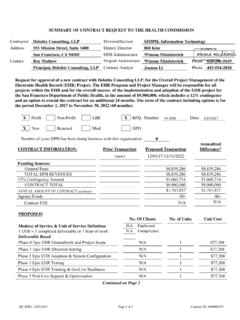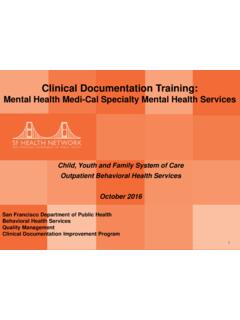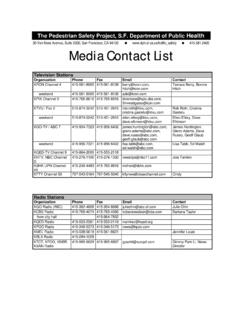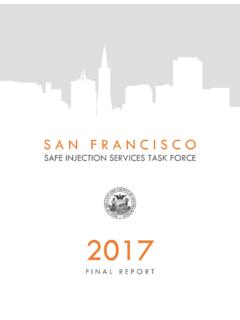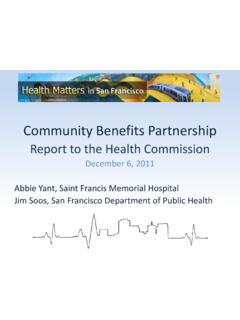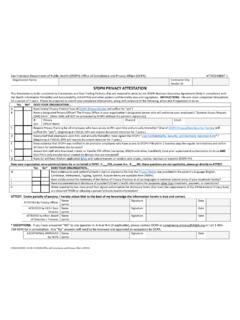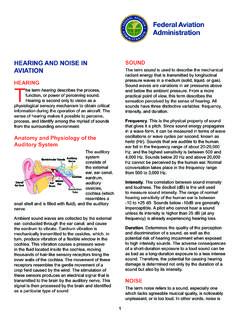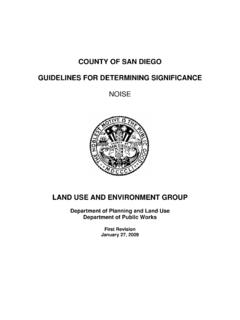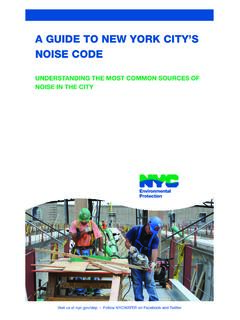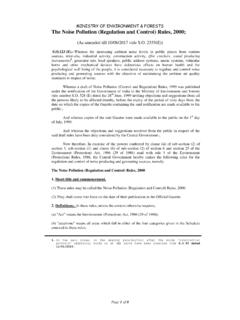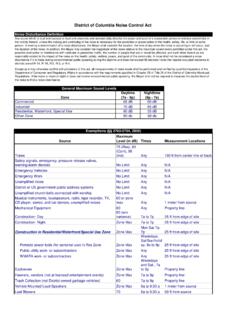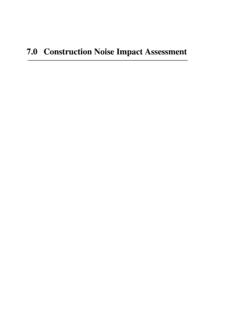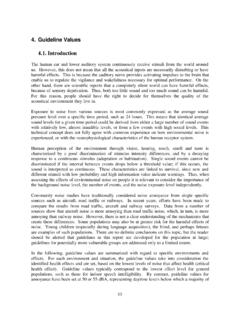Transcription of San Francisco Guidance for Noise Management and …
1 CITYWIDE Noise Guidance December 2014 Page |1. San Francisco Police Code Article 29: Regulation of Noise Guidelines for Noise Control Ordinance Monitoring and Enforcement December 2014 Guidance (Supersedes all previous Guidance ). San Francisco Police Code Article 29 provides the authority to the Director of the Department of Public Health to issue and amend rules, regulations, standards, guidelines, or conditions in order to implement and enforce the Noise ordinance (SFPC 29, Section 2920). This 2014 Guidance document describes the roles of the city agencies and serves as clarification of the existing law, not a new interpretation. Attached in the appendix are agency-specific Guidance and enforcement resources. This Guidance is subject to change, revision, or modification. CITYWIDE Noise Guidance December 2014 Page |2. Background With its diverse and active population, proximity of homes to businesses, urban traffic, and construction, San Francisco can be a loud place.
2 Sound is inevitable in cities, yet levels or types of sound occurring in some parts of San Francisco may be bothersome to residents and workers and in some cases could be high enough to harm health and quality of life. Everyone reacts differently to Noise , Any unwanted sound can be characterized as Noise ; everyone and not everyone reacts differently to Noise , and not everyone agrees about what agrees about what sounds are noisy. What can be unbearable for one person may sounds are noisy. pass almost unnoticed by another for example, some people become irritated by music playing in an elevator while others may not even notice this sound. Health effects may result from prolonged exposure to very loud sounds, from transient loud sounds that interrupt sleep, or when unwanted sound causes stress or annoyance. How annoyed any one person may become depends on many factors including the loudness, time, place, frequency and source of the Noise .
3 There is substantial emerging research that regular access and use of quiet or silent spaces helps to prevent annoyance and improves tolerance to unwanted sound. Oversight Federal, state, and local laws limit Noise from transportation, construction, mechanical equipment, entertainment, and human behavior. In San Francisco , Article 29 of the Police Code (SF Police Code Article 29) specifies the joint responsibility of the Department of Public Health, the Police Department, the Department of Building Inspection, the Many agencies share responsibility Department of Public Works, the Municipal for enforcing Noise laws in San Transportation Agency the Rent Board, the Francisco . Complaints should be Planning Department, the Department of made to 311 so that your request can Recreation and Parks, and the Entertainment be routed to the correct agency. CITYWIDE Noise Guidance December 2014 Page |3. Commission for collectively sharing the responsibilities for Noise control and prevention (see Appendix A).
4 Noise and sound are also governed or referenced in several other San Francisco Codes (see Appendix B). Noise is a subjective quality one person's music is another's annoyance. Many noises and sounds are not covered by the Noise control laws in San Francisco . These include wind chimes, the unamplified human voice, leaf blowers, and other sounds (see Appendix C). Good neighbor Policy When citizens have complaints about any sound, whether it is covered by a specific law or not, all agencies that regulate Noise in San Francisco advise people to attempt to discuss the issue If you are disturbed by a directly with the person or entity producing the sound, first try to discuss the sound in order to try and achieve a solution. Give issue directly with whoever is them an appropriate time frame to do something producing the sound to find a about it. If the situation hasn't changed after that mutually agreeable solution.
5 Time, it may then be necessary to contact the appropriate authority that regulates or limits the particular Noise source. CITYWIDE Noise Guidance December 2014 Page |4. Summary of the Code Article 29 of the police code specifies: HOW sound can be measured for compliance purposes. Requirements include: Type I meter must be used Response settings and weighting must be set appropriately Instruments must be calibrated WHEN sound can be measured for compliance purposes. It is not required that Noise investigations and sound measurements be conducted at the exact time of a Noise complaint. WHERE sound must be measured for compliance purposes. Requirements include: The location must have safe access Measurements must be taken in specific areas and distances from walls or other Noise sources For indoor measurements, window position must comply with specific requirements The meaning of ambient sound for compliance purposes.
6 The application of this definition to varying environments is described in this Guidance . CITYWIDE Noise Guidance December 2014 Page |5. Contents 1. Sound Level Measures Sound Level Meters .. 7. Settings .. 7. Calibration .. 8. Measurements with a Sound Level Meter .. 8. Measurements of Audibility (without a Sound Level Meter) .. 9. San Francisco Codes that refer to an audible standard .. 9. 2. Measurement Location General .. 10. Indoor Noise Measurements .. 10. Outdoor Noise measurement location .. 11. Threshold Distances .. 12. 3. Time of Day for Measurements Response and Investigation .. 13. Third Party Acoustical Reports .. 13. Night Times .. 13. 4. Detailed Enforcement and Descriptions of Standards Police Code Article 1, Section 49, Unnecessary Noise , Authorized Emergency 14. Police Code Article 29, Section 2904, Waste Disposal Services .. 15. Police Code Article 29, Section 2905, Vehicle and Nonstationary Source Repairs.
7 15. Police Code Article 29, Section 2907, Construction Equipment .. 16. Police Code Article 29, Section 2908, Construction Work at Night .. 16. Police Code Article 29, Section 2909, Fixed Noise sources .. 17. Police Code Article 29, Section 2913, Use of Amplified Sound on Unenclosed Tour Buses .. 19. 5. Determination of ambient Definition of ambient .. 20. Contributions to ambient .. 20. ambient Limitations .. 20. 6. Enforcement, Investigation and Appeals .. 21. CITYWIDE Noise Guidance December 2014 Page |6. 7. Variances .. 22. 8. Exceptions .. 23. 9. Repeat Complaints .. 23. APPENDICES .. APPENDIX A Selected Regulatory Codes and Standards In Police Code Article 29 Relevant to Noise and Sound in San Francisco .. 25. APPENDIX B Occurrences of Noise References in San Francisco City Codes .. 26. APPENDIX C Exceptions .. 30. APPENDIX D Safe Practices for Roof Work .. 31. APPENDIX E: DBI Night Noise Permits.
8 35. APPENDIX F: DPW Night Noise Permits .. 39. APPENDIX G: Entertainment Commission Good Neighbor Policy .. 43. APPENDIX H: DPH Draft Guidelines for Restaurant Plan Check .. 45. CITYWIDE Noise Guidance December 2014 Page |7. 1. Sound Level Measures Sound Level Meters The American National Standards Institute (ANSI) Standard , "Specifications for Sound Level Meters" sets performance and accuracy Article 29 of the Police Code specifies that tolerances according to three a Type 1 meter shall be used for levels of precision: Types 0, compliance purposes. 1, and 2. Type 0 is used in laboratories, Type 1 is used for precision measurements in the field, and Type 2 is used for general-purpose measurements. Readings with an ANSI Type 2 sound level meter have an accuracy of dBA, whereas a Type 1 instrument has an accuracy of dBA. While Type 2 meters may be used by Departments for general purpose Noise surveys, Article 29 of the Police Code specifies that a Type 1 meter shall be used for compliance purposes.
9 Sound level measurements from smart phone applications are not reliable and shall not Sound level measurements from considered or reviewed for any purposes. smart phone applications are not reliable Settings Article 29 of the Police Code specifies that sound level meter response settings must be set in accordance with the particular Noise that is measured. The sound level meter shall be set to slow response for continuous Noise sources and fast response for Noise with rapid onset and decline. CITYWIDE Noise Guidance December 2014 Page |8. For most Noise sources, compliance is assessed only on the A-weighted relative sound pressure level. Article 29 of the Police Code specifies that sound level meters shall be set to A-weighting which accounts for the audio frequencies most sensitive to the human ear. In addition to the A- weighting, compliance for a licensed Place of Entertainment or a Limited Live Performance Locale (or other venues enforced by the Entertainment Commission) is also assessed For all enforcement except using the C-weighted relative sound entertainment or performance pressure level which includes more lower venues, the sound level meter must audio frequencies.
10 Be set to the A weight. Calibration To ensure measurement accuracy, all instruments must be calibrated according to the manufacturer's instructions. In addition, field calibration shall be performed prior to and after each Instruments must be calibrated use and whenever temperature and/or relative humidity in the field. changes significantly. Measurements with a Sound Level Meter Article 29 of the Police Code defines the Noise level, as measured with a sound level meter, as the maximum continuous sound level or repetitive peak sound level produced by a source or group of sources. The inspector or agency investigating the sound determines the appropriate period of time over which to take the measurement. If a group of sources on one property is contributing to the Noise issue and are all under the control of the property owner, the group shall be treated as a single source and for compliance purposes the Noise level shall be measured with all sources operating unless the owner can provide visual and/or written documentation that proves the sources are incapable of operating either simultaneously or as In many situations managing the correctly calculated using sound from one or two of a group of standard methods.
